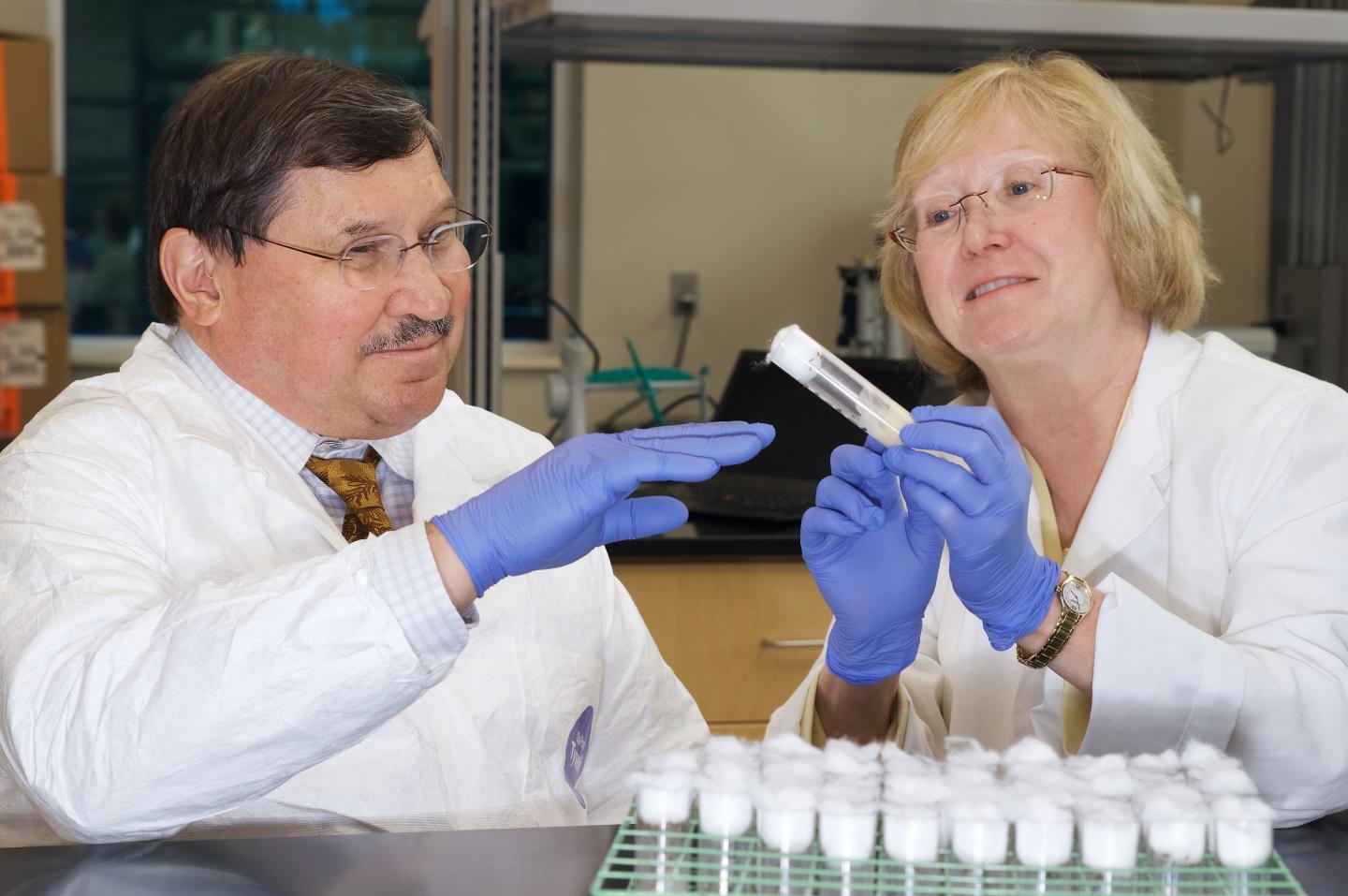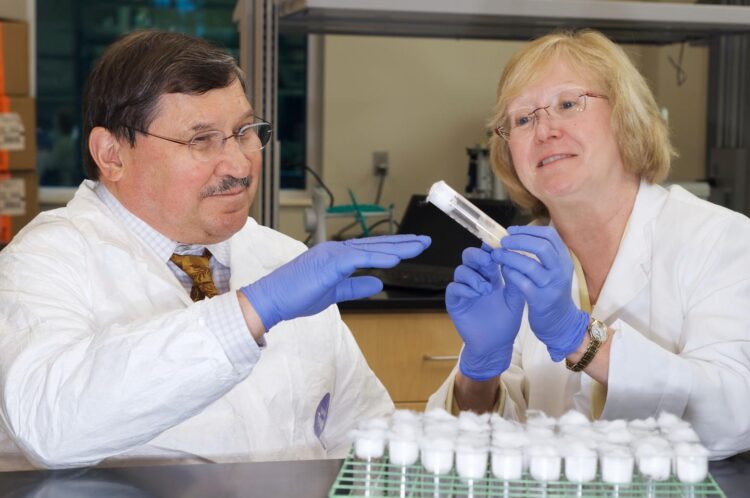Clemson researchers are a part of the international PrecisionTox consortium which aims to shape regulation and policy on chemical safety without the use of animal testing

Credit: Clemson University College of Science
Researchers Trudy Mackay and Robert Anholt of the Clemson University Center for Human Genetics have joined forces with an international consortium intended to drive research that will shape regulation and policy on chemical safety without the use of animal testing.
Mackay, an internationally renowned scientist and director of the Center for Human Genetics (CHG), will team with Anholt to explore the genetic underpinnings of susceptibility to environmental toxicants using Drosophila melanogaster, the common fruit fly.
Clemson is one of 15 international institutions – and one of only two in the United States – involved in the consortium led by the University of Birmingham in the United Kingdom. The European Commission’s Horizon 2020 program is funding the five-year, $23.4 million PrecisionTox project. The CHG will receive approximately $1.2 million.
“Being a part of this consortium allows us to collaborate with researchers across Europe to study the genetic implications of environmental pollutants,” said Anholt, Provost’s Distinguished Professor of Genetics and Biochemistry and also director of faculty excellence initiatives in the College of Science.
Environmental pollutants are a major source of compounds that can adversely affect the quality of life and cause disease and death.
The consortium, led by John Colbourne of the University of Birmingham, will use genetics, genomics, metabolomics and the study of evolution to investigate the toxicity of hundreds of chemicals and explore how they disrupt the biological processes fundamental to health. Combined with law, these approaches will open up a new field of precision toxicology to transform approaches to chemical safety management in the same way precision medicine informs health care.
“Because humans share many genes with these organisms by evolution, we can use them to map the genetic and metabolic pathways that are also important for human health. This shared biology will help us understand how these genetic connections and interactions can be affected by chemicals in the environment – and that will help us better protect the health of all animals, including humans,” Colbourne said.
Regulatory toxicology has typically relied on animal testing to determine at what point exposure to a toxin is no longer safe for humans. PrecisionTox aims to identify molecular key event biomarkers in non-mammalian models that are predictive of adverse health outcomes.
That’s where Mackay and Anholt and their fruit fly research comes in.
“About 75 percent of human disease genes have a counterpart in fruit flies, which are not subject to regulatory restrictions like vertebrate animals,” Mackay said.
Fruit flies are excellent experimental genetic organisms because researchers can easily manipulate their genomes and tightly control their environments. They also have very short lifespans, meaning researchers can have a new generation in a couple of weeks rather than years.
Mackay’s laboratory developed the Drosophila melanogaster Genetic Reference Panel (DGRP), which now consists of 1,000 inbred fly lines with fully sequenced genomes derived from a natural population. The DGRP allows researchers to use naturally occurring variation to examine genetic variants that contribute to susceptibility to various stressors.
For the PrecisionTox project, CHG researchers will examine the flies’ genetic architecture that provides susceptibility to eight common toxins, including arsenic, a major pollutant of groundwater in some countries in Asia and some areas of the United States. The initial focus on arsenic dovetails well with previous studies conducted by Mackay and Anholt on the genetic underpinnings of susceptibility to heavy metals, including lead, cadmium and methyl mercury.
“After we identify genes and genetic networks, we can superimpose human genes and human genetic networks to essentially use the fly as a gene discovery system for human studies. The information will be integrated with other projects of the consortium that are working on human cell lines,” Anholt said.
“We’re trying to put all of this information at the level of the environmental responses of the genome to find commonalities across these scales that are likely to apply to humans as well, without actually having to do the work in humans, which is very difficult,” Mackay added. “We’re hoping to have some biomarkers that are conserved from the fruit fly to human cell lines that could potentially be used to assess exposure in the blood of actual individuals.”
Other consortium members are Indiana University, Ruprecht-Karls-Universität Heidelberg, Karlsruher Institut für Technology, Helmholtz-Zentrum für Umweltforschung GMBH- UFZ and Cell Networks GMBH in Germany; Fundacio Centre de Regulacio Genomica and Acondicionamieto Tarrasense Association in Spain; Watchfrog in France; The University of Oxford and Michabo Health Science Ltd. In the U.K.; Altertox in Belgium; Misvik Biology OY in Finland; and Latvia MGI Tech SIA in Latvia.
“It was important to us to be a part of this international collaboration and to be able to do the science,” Anholt said. “We are grateful to Clemson’s Division of Research and the Clemson University Research Foundation, who made this possible by patiently navigating the administrative complexities of this international consortium under a looming Brexit deadline.”
“For us, it’s not just a matter of toxicology. It is a wider view for us. We are very much interested in understanding how environmental effects affect the genome, so it’s the nurture versus nature notion,” Anholt concluded. “We know many of the traits of susceptibility to disease are due to networks of interacting genes. But these networks of genes are affected by environmental influences, and we know very little in general about how environmental influences interact with the genome.”
The Center for Human Genetics is part of Clemson University’s College of Science and is housed in Self Regional Hall, a state-of-the-art research facility located on the campus of the Greenwood (S.C.) Genetic Center. The CHG’s research focuses on genomic, computational and comparative genetic approaches to gain insights in genetic and environmental risk factors for human diseases.
PrecisionTox is a project funded by the European Commission H2020 programme until 2026 under Grant Agreement No. 965406. Its mission is to accelerate discoveries and the implementation of new approach methodologies for chemical safety testing that are useful at protecting the health of populations and the environment by Precision Toxicology.
###
Media Contact
Cindy Landrum
[email protected]
Original Source
https:/





